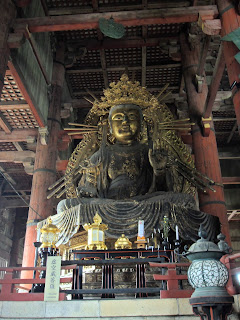Kinkaku-ji is the "Golden Pavilion" and my number one recommended temple of Kyoto. Unlike Ginkaku-ji, this one actually is plated with gold and situated right in the center of a body of water. On a sunny day, the golden temple reflects off the water and creates a beautiful scenery. The place gets really crowded no matter the time of year, though, so the best time to go is either right when it opens (at 9:00) or shortly before it closes (at 17:00).


 |
| 鏡湖池 Mirror Pond |
Actually, there is a myth that says that the emperor of China (I forget which), in search for the fountain of youth and eternal life, did send a group of people out towards Japan. Those people, failing to find it, were afraid of going back empty-handed, so they decided to settle down in there. That's why a lot of the temple and building architecture in Japan is so similar to those of China. I don't know the degree of truth to this myth, but after learning about the construction of Kinkaku-ji, it makes me wonder.
 |
| coin toss |
Unexpectedly, we were able to see Daimonji-san outside of the temple! What a nice surprise! I had been looking for this mountain for forever since hiking Fuji.
We headed out for Nara in the afternoon and got our first stamp on the 18kippu. Nara was fairly close by (only 40 minutes away from Kyoto). There were three things I wanted to do in Nara: visit the daibutsu, feed the deer, and eat the local food. All of those were located in the same general area, so we went to eat first.


Kyoto Station: Japan's second largest station building (first being Nagoya (JR Headquarters)).
Everything is there; there is a shopping mall, a hotel, a movie theater, the Isetan (department store)–you name it–there are even government facilities here. Oh, and not to forget the trains that can take you everywhere in the Kansai region.
 |
| Manto-kun With a temple roof as a hat, deer hoofs and antlers, and a white cape, I can say one thing about him: so cute!~ and so ideally Japanese. So which do you think is more fit to be the mascot? |

The restaurant we went to was called Shizuka and they served a local Nara food, called kamameshi, which is iron-pot cooked rice with burdock, carrots, asparagus, egg, etc. on top. The pot is extremely hot, so you have to be careful.

But basically, you scoop your rice out into a bowl to eat, so every time you do so, make sure you put the lid back on because that is what will help produce okoge, which is slightly burnt rice at the bottom and sides of the pot (aka the best part ;), you guys know how much I like <slightly> burnt food). So it’s kind of like stone-cooked rice.
They even give you directions in English and Japanese on how to eat kamameshi.
 |
| kamameshi 釜飯 |
 |
| okoge, "scorched rice" お焦げ reminds me of Chinese guoba 鍋巴 |
We headed to see the daibutsu next (The Great Buddha), which is located in Todai-ji. Along the way, we crossed Nara-koen (Nara Park) and were able to see a lot of sika deer.
Beware, though, as deer are still wild animals and may bite, kick, headbutt, or knock you down.
 |
| Entrance to Todai-ji |
 |
| The Daibutsu Hall |
 |
| purification |
 |
| The Great Buddha 大仏 |
The Great Buddha Hall was reallllly big, with pillars that must have come from trees that were several thousand years old.
But aside from the Great Buddha, there were also statues of other deities.
 |
| incense |
 |
| We stumbled across Mount Wakayama, where deer can be seen running up and down a hill. |
 |
| and this fraudulent vending machine outside one of the souvenir shops. >o< (here's why) |
 |
| a nice hut in the mountains |


Sagihara Pathway
鷺原道
 |
| spotted our first deer in the mountains. These deer were much gentler than the deer in Nara Park, probably because they aren't as exposed to humans. |
Sagihara Street eventually led us to this open grassland, where there were tons of deer. Once I reached into my bag for a senbei, they all started advancing towards me.
There was this one deer that was reallllly persistent. I did give it a senbei, but I wanted to feed the other deer, too, so I moved away from it. But it kept following me and even bit me! How vicious. That's the last time I'm feeding Nara deer.
Afterwards, we headed back to the train station and headed off to Osaka!
We decided to have okonomiyaki for dinner at this restaurant called Yukari.
 |
| of course, you need the spatula for okonomiyaki |


It was sooo delishh. Osaka okonomiyaki is definitely different from the others I had. These ones had toppings. (I can't believe I don't have a picture of the final products. Please watch video below to see.)
 |
| and the summer limited yakisoba |
By the way, the accommodation we booked for is at Hotel Il Grande Umeda. We will be staying here for two nights. ¥6750 for a room for two (one full sized bed, full amenities). Will review later.





























No comments:
Post a Comment